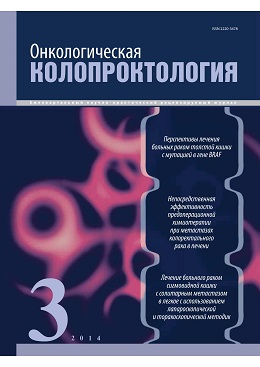Vol 3, No 3 (2014)
- Year: 2014
- Published: 26.09.2014
- Articles: 7
- URL: https://onco-surgery.info/jour/issue/view/5
REVIEW
PROMISES FOR TREATING COLON CANCER PATIENTS WITH BRAF GENE MUTATION
Abstract
Colon cancer represents a heterogenous disease group, which differ by cancerogenesis mechanisms, molecular alterations, prognosis and treatment possibilities. In modern clinical practice assessment of KRAS and NRAS genes status is already necessary in order to prescribe anti-EGFR treatment for metastatic disease. A separate poor prognosis group are patients with BRAF mutation. In this review we will focus on biological features of BRAF-mutant colorectal cancer, its epidemiology, clinical features on different stages, treatment choice and promising new treatment possibilities.
 9-16
9-16


MORPHOLOGICAL ASSESSMENT OF LATERAL EDGE OF A RESECTION AS A FACTOR OF THE FORECAST OF LOCAL RECURRENCE AT A CANCER OF A RECTUM. FORECASTING OF RECURRENCE OF A TUMOR BY MEANS OF AN ASSESSMENT OF MARKERS OF A COLORECTAL CANCER
Abstract
This is a review of the literature on the application of magnetic resonance imaging as a method of preoperative staging of colorectal cancer, total mesorectal excision with pathologic evaluation of the lateral resection margin and the clinical significance of molecular markers of drug therapy.
 17-22
17-22


ORIGINAL REPORTS
COMBINATION NEOADJUVANT THERMOCHEMICAL THERAPY IN PATIENTS WITH RECTAL CANCER
Abstract
A new combined treatment scheme with short-course chemoradiotherapy and 2 selective radiosensitizers (metronidazole in a polymeric composition and local hyperthermia) is investigated in this article.
Material and methods. 77 T1–3N0–2M0 rectal cancer patients treatment data was analyzed. All patients received 5 Ч 5 Gy radiotherapy with capecitabine 1300 mg/m2 days 1–5 per os and radiosensitization with local hyperthermia and metronidazole.
Results. Investigated treatment scheme has acceptable toxicity and leads to high local control rate (none of the patients experienced local recurrence). 7 (9.1 %) patients developed distant metastases. 59 (76.6 %) patients had sphincter-sparing surgery. Median followup was 65.6 months. 5-year survival rate was 81.7 %.
Conclusion. Developed treatment scheme is safe and leads to high local control rate.
 23-28
23-28


PREOPERATIVE CHEMOTHERAPY FOR COLORECTAL CANCER LIVER METASTASES: SHORT-TERM RESULTS
Abstract
 29-34
29-34


BEVACIZUMAB USE IN METASTATIC COLORECTAL CANCER IN THE FACILITIES OF DAY HOSPITAL OF REGIONAL ОNCOLOGY DISPENSARY
Abstract
Purpose. To conduct retrospective analysis of first line therapy with bevacizumab received by patients treated in Perm Regional Oncology Dispensary.
Methods. Analysis of treatment results of 28 patients who received first line metastatic colorectal cancer (mCRC) treatment including bevacizumab in Perm Regional Oncology Dispensary. Patients received bevacizumab 5 mg/kg every 2 weeks or 7.5 mg/kg every 3 weeks in combination with FOLFOX, XELOX or capecitabin monotherapy in first line treatment until disease progression. Patients continued bevacizumab with change of chemotherapy regimen after first disease progression if it was possible due to performance status.
Results. Disease control was reached in 21 (75 %) cases. Complete remission was detected in 3 (10.7 %) of patients, partial remission in 9 (32.15 %), disease stabilization in 9 (32.15 %) and disease progression in 7 (25.0 % ) of patients. Median time to progression was 12 months (from 4 to 36 months). R0 liver metastases resection was performed in 9 (35.7 %) patients after treatment. Median Overall Survival was 25 months.
Conclusions. The results of retrospective analysis are in line with the data of International Clinical Trials of bevacizumab in the mCRC therapy. Continuous bevacizumab treatment from first line with the following maintenance until disease progression and further continuation in second line treatment with the chemotherapy regimen change until progression made possible to increase the efficacy and survival of patients. Bevacizumab demonstrated good tolerability and did not increase toxicity of chemotherapy.
 35-38
35-38


DRUG THERAPY PROBLEMS DURING PALLIATIVE ONCOLOGY CARE
Abstract
Introduction. Palliative care for oncological patients requires dealing with multiple disease symptoms and requires multi-drug therapy. The search for wide-spectre drugs which can affect different pathological pathways is a pressing matter.
Methods. The effect of hydralazine sulfate on life quality of 63 palliative care oncological patients ECOG > 3, who stopped all specific therapy was investigated.
Results. Positive correlation between hydralazine sulfate use and dose of analgetics was observed, as well as reduction of need for symptomatic therapy. The median daily use of tramadol slightly increased from 263.5 ± 4.7 to 317.2 ± 3.4 mg. In 19.4 % patients after 1 month of hydralazine sulfate therapy pain was reduced to “low” and tramadol was cancelled. Decrease in symptomatic therapy need was observed in 85 % patients.
Conslusion. Use of hydralazine sulfate in palliative oncological care improves treatment and life quality.
 39-43
39-43


CASE REPORT
TREATMENT USING LAPAROSCOPIC AND THORACOSCOPIC PROCEDURES IN A PATIENT WITH SIGMOID CANCER AND SOLITARY PULMONARY METASTASIS: A CLINICAL CASE
Abstract
A clinical case of a sigmoid cancer patient with solitary lung metastasis is discussed in this article. Use of minimally invasive surgical technologies allowed to perform a simultaneous combined surgery on abdominal and thoracic cavities and improve rehabilitation time and time to systemic chemotherapy initiation. In presented clinical case patient was comorbid with stage III obesity, which was considered as a contraindication to laparoscopic surgery for a long time.
 44-48
44-48











